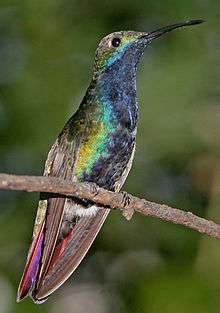Black-throated mango
| Black-throated mango | |
|---|---|
 | |
| Male at Puerto Iguazú, Misiones Province, Argentina | |
_female.jpg) | |
| Female in Tobago | |
| Scientific classification | |
| Kingdom: | Animalia |
| Phylum: | Chordata |
| Class: | Aves |
| Order: | Apodiformes |
| Family: | Trochilidae |
| Subfamily: | Trochilinae |
| Genus: | Anthracothorax |
| Species: | A. nigricollis |
| Binomial name | |
| Anthracothorax nigricollis (Vieillot, 1817) | |
The black-throated mango (Anthracothorax nigricollis) is a mainly South American hummingbird species.
Description
It is 10.2 cm long and weighs 7.2g. The longish black bill is slightly decurved. The tail in both sexes has dark central feathers, the outer tail being wine-red tipped with black.
The male has glossy bright green upperparts. His throat and chest are matt black, bordered with blue-green. The flanks are bright green, and the black of the chest tapers onto the belly.
The female black-throated mango has bronze-green upperparts and white underparts with a black central stripe. Immature birds show some grey or buff feather tips on the head and wings, and have brown around the eyes.
The call of the black-throated mango is a high-pitched tsiuck, and the song is a buzzing hsl-hsl-hsl-hsl-hsl-hsl-hsl.
This species is very similar to the closely related green-breasted mango. Although the male black-throated mango has more extensive black on the underparts, this and other plumage differences are not always easy to confirm in the field because the birds appear all-black. The females of the two species can be almost inseparable, although the black-throated lacks the more extensively coppery upperpart of its relative.
Distribution and ecology
It breeds from Panama south to northeasterm Bolivia, southern Brazil and northern Argentina. It is also common on both Trinidad and Tobago. It is a local or seasonal migrant, with some birds moving up to 1000 miles, although its movements are not well understood.
This small bird inhabits open country, gardens and cultivation. Though it will adapt to human activity, it seems less of a generalist than for example the gilded sapphire (Hylocharis chrysura) or the sapphire-spangled emerald (Amazilia lactea).[2]
The food of this species is nectar, often taken from the flowers of large trees. This hummingbird is also notably insectivorous, often hovering in open areas to catch flying insects. It appears to be somewhat picky regarding favorite foodplants and often does not visit ornamental plants popular with many other hummingbirds, such as Erythrina speciosa or Stifftia chrysantha; certain ornamental Bignoniaceae like the fountain tree (Spathodea campanulata) seem more to this bird's liking.[2] While feeding, it has been observed to dominate over a glittering-bellied emerald (Chlorostilbon lucidus) and to be displaced by a gilded hummingbird, both considerably smaller species.[2]
The black-throated mango's breeding season lasts almost year-round in most of its range. It builds a tiny cup nest on a high, thin, and usually bare branch.[3] For this it uses fluff like seed down, cladding the outside with lichen. Nests are maybe 35–40 mm wide and 25–30 mm tall on the outside and some 25 mm wide and 10–15 mm deep inside. The two all-white eggs measure c.15 by 9.5 mm. They are incubated by the female for 16 or 17 days, and fledging takes another 24.[4]
At a black-throated mango nest in Cuyabeno Faunistic Reserve, Ecuador, it was noted that the tree was beset with Pseudomyrmex stinging ants. This was also noted at a green-breasted mango nest on San Andrés Island (Caribbean). It is likely that the ants would deter predators, but it is not known whether the birds deliberately select such trees for nesting.[4]
Gallery
-

female, Brazil
-
.jpg)
female
-
female on nest at Novo Mundo, Mato Grosso State, Brazil
Footnotes
- ↑ BirdLife International (2012). "Anthracothorax nigricollis". IUCN Red List of Threatened Species. Version 2013.2. International Union for Conservation of Nature. Retrieved 26 November 2013.
- 1 2 3 Baza Mendonça & dos Anjos (2005)
- ↑ E.g. of Macrolobium sp. (Greeney & Merino M. 2006)
- 1 2 Greeney & Merino M. (2006)
References
- Baza Mendonça, Luciana & dos Anjos, Luiz (2005): Beija-flores (Aves, Trochilidae) e seus recursos florais em uma área urbana do Sul do Brasil [Hummingbirds (Aves, Trochilidae) and their flowers in an urban area of southern Brazil]. [Portuguese with English abstract] Revista Brasileira de Zoologia 22(1): 51–59. doi:10.1590/S0101-81752005000100007 PDF fulltext
- ffrench, Richard; O'Neill, John Patton & Eckelberry, Don R. (1991): A guide to the birds of Trinidad and Tobago (2nd edition). Comstock Publishing, Ithaca, N.Y.. ISBN 0-8014-9792-2
- Greeney, Harold F. & Merino M., Paúl A. (2006): Notes on breeding birds from the Cuyabeno Faunistic Reserve in northeastern Ecuador. Boletín de la Sociedad Antioqueña de Ornitología 16(2): 46-57. PDF fulltext
- Hilty, Steven L. (2003): Birds of Venezuela. Christopher Helm, London. ISBN 0-7136-6418-5
External links
| Wikimedia Commons has media related to Anthracothorax nigricollis. |
- Black-throated Mango videos on the Internet Bird Collection
- Stamps (for Trinidad and Tobago) with RangeMap
- Black-throated Mango photo gallery VIREO Photo-High Res
- Photo-High Res; Article tsgcs.co.uk
- Photo-High Res--Bird sitting on Nest; Article www1.nhl.nl—"Suriname Birds"—Map and 4 High Res photos
